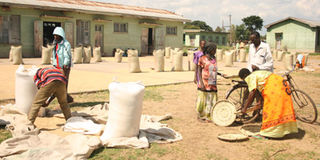To curb post-harvest losses, hope lies in strengthening cooperatives

Rice farmers pack their harvest into sacks for the market. Cooperatives can play a major role in helping farmers reduce post-harvest losses. FILE PHOTO
What you need to know:
Farmers invest a lot of resources before reaching the harvest level, it is really ironical that they suffer losses at such a stage near reaping from their time and financial investments
Post-harvest losses are food losses. Each step of the way from farm to market, there are more and more losses.
In a developing country like Uganda, food security relies on producing and storing major staple crops such as grain. However, post-harvest commodity losses remain particularly high.
More than 25 per cent of the grain produced is lost in the entire post-harvest chain before reaching the consumer.
These losses occur at every stage: harvest, transport, drying, shelling, winnowing, sorting/packaging, storage, and even during transportation to the market and in-market storage.
Food losses still high
Like many other parts of world, grains represent the basis for food security for most of East Africa’s population. More than 80 per cent of East Africans are involved in agriculture. For instance, in Rwanda, despite a national post-harvest strategic policy to reduce losses of food grain crops from nearly 30 per cent in 2010 to 15 per cent in 2015, the Ministry of Agricultural and Animal Resources reports that losses are still hovering around 25 per cent. The losses remain significantly huge.
In March-April 2016, I worked with Usaid/Enabling Market Integration through Rural Group Empowerment (EMIRGE) East Africa.
The objective of EMIGRE was to understand the major issues and threats around post–harvest handling and storage.
However, from my field observations and discussions with farmers and agro-processors, post-harvest loss is a solvable problem.
What if we reduced these nearly 25 per cent of food grain losses to an admissible 10 per cent and turn lost grains into marketable food?
Attacking the root causes can contribute significantly to improve millions of East African farmers’ lives.
If small-scale farmers could use hermetic bags, hermetic plastic, and/or small metallic silos, they could reduce up to 40 per cent on farm crop loss.
The role of cooperatives
Farmers invest a lot of resources before reaching the harvest level, it is really ironical that they suffer losses at such a stage near reaping from their time and financial investments.
To mitigate post-harvest losses, we need to strengthen agricultural cooperatives to generate collective capacity to deal with the challenge.
Cooperatives and private firms could collaboratively invest in larger storage capacities to accommodate farmers’ harvests in their respective regions.
Additionally, traders could build large-scale warehouses for their businesses.
Cooperative unions could play a more active role by investing in an improved storage facility in each district and lead the crop collection activities for member cooperatives.
While this strategy would require interlinked support from government and other stakeholders, it would also increase the investment in having successful cooperatives in the region.
Another key strategy would entail collection points in different districts in order to ease the shortage of post-harvest drying and storage facilities common in our region.
Banks should develop financial lending products to facilitate the building of processing facilities for value addition. This would save the valuable funds lost by East African countries because much of the processing occurs outside of their borders.
EMIRGE East Africa program has taken the initiative to conduct an investigative study to determine the percentage loss and formulate recommendations to reduce the current crop loss.
The findings will be shared with other stakeholders engaged in poverty reduction, food security of small households and the cooperative development movement in the region.
The writer is a member of the National Cooperatives Stakeholders’ Steering Committee.




